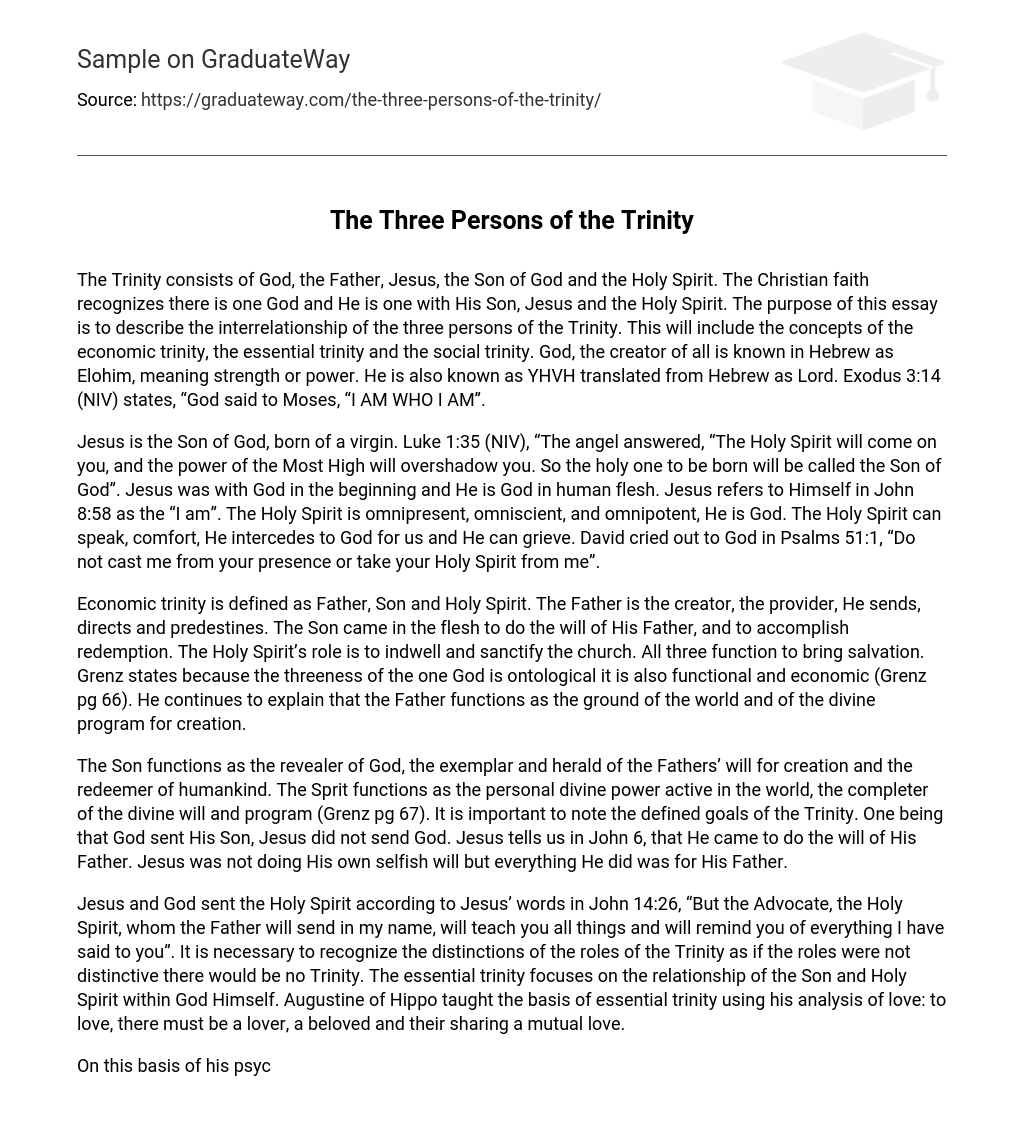The Trinity consists of God, the Father, Jesus, the Son of God and the Holy Spirit. The Christian faith recognizes there is one God and He is one with His Son, Jesus and the Holy Spirit. The purpose of this essay is to describe the interrelationship of the three persons of the Trinity. This will include the concepts of the economic trinity, the essential trinity and the social trinity. God, the creator of all is known in Hebrew as Elohim, meaning strength or power. He is also known as YHVH translated from Hebrew as Lord. Exodus 3:14 (NIV) states, “God said to Moses, “I AM WHO I AM”.
Jesus is the Son of God, born of a virgin. Luke 1:35 (NIV), “The angel answered, “The Holy Spirit will come on you, and the power of the Most High will overshadow you. So the holy one to be born will be called the Son of God”. Jesus was with God in the beginning and He is God in human flesh. Jesus refers to Himself in John 8:58 as the “I am”. The Holy Spirit is omnipresent, omniscient, and omnipotent, He is God. The Holy Spirit can speak, comfort, He intercedes to God for us and He can grieve. David cried out to God in Psalms 51:1, “Do not cast me from your presence or take your Holy Spirit from me”.
Economic trinity is defined as Father, Son and Holy Spirit. The Father is the creator, the provider, He sends, directs and predestines. The Son came in the flesh to do the will of His Father, and to accomplish redemption. The Holy Spirit’s role is to indwell and sanctify the church. All three function to bring salvation. Grenz states because the threeness of the one God is ontological it is also functional and economic (Grenz pg 66). He continues to explain that the Father functions as the ground of the world and of the divine program for creation.
The Son functions as the revealer of God, the exemplar and herald of the Fathers’ will for creation and the redeemer of humankind. The Sprit functions as the personal divine power active in the world, the completer of the divine will and program (Grenz pg 67). It is important to note the defined goals of the Trinity. One being that God sent His Son, Jesus did not send God. Jesus tells us in John 6, that He came to do the will of His Father. Jesus was not doing His own selfish will but everything He did was for His Father.
Jesus and God sent the Holy Spirit according to Jesus’ words in John 14:26, “But the Advocate, the Holy Spirit, whom the Father will send in my name, will teach you all things and will remind you of everything I have said to you”. It is necessary to recognize the distinctions of the roles of the Trinity as if the roles were not distinctive there would be no Trinity. The essential trinity focuses on the relationship of the Son and Holy Spirit within God Himself. Augustine of Hippo taught the basis of essential trinity using his analysis of love: to love, there must be a lover, a beloved and their sharing a mutual love.
On this basis of his psychological analogy, Augustine argues for a threefold understanding of the Godhead, in terms of the Father, Son and Holy Spirit (McGrath, pg 195). Augustine states that just as there are three entities of the mind, there can be three persons of God. Grenz describes social Trinity as the community of love. God loves His Son, Jesus, who reciprocates this love to God the Father and this love between God and His Son is the Holy Spirit (Grenz pg 72). Throughout the New Testament Jesus is referred to as the Son of God meaning a family relationship.
Social Trinity can be hard to comprehend as in family units each person is an individual. In the Trinity, God, Jesus and the Holy Spirit are one. They are not individuals; they are the same, each conducting different tasks. The purpose of this essay was to describe the interrelationship of the three persons of the Trinity. This included the concepts of the economic trinity, the essential trinity and the social trinity. Even though the word Trinity does not appear in the Bible, the concept of Trinity is evident throughout scripture.





